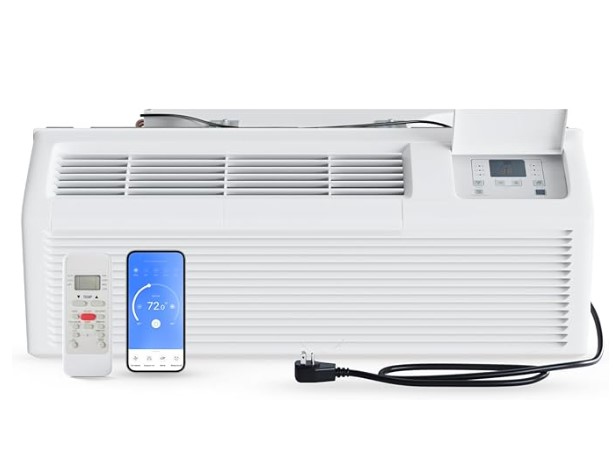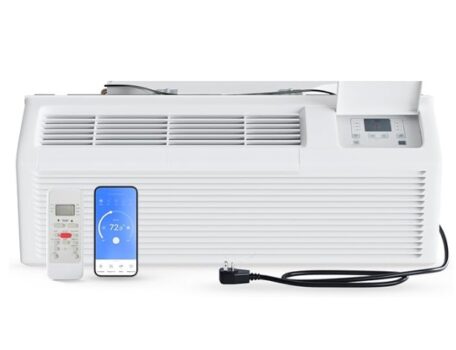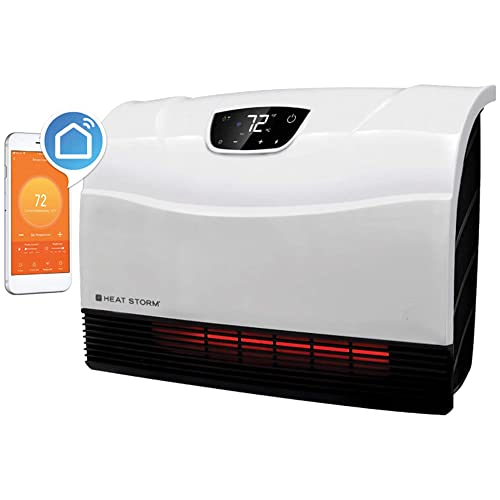The step-by-step guide “How to upgrade an existing Basement Heating System?” is designed to assist homeowners in enhancing the efficiency and effectiveness of their current basement heating system. By following these instructions, individuals can make informed decisions to improve their heating system’s performance and create a more comfortable living environment in their basement.
Whether it is upgrading the insulation, replacing outdated equipment, or adjusting the thermostat settings, this guide offers practical advice to help homeowners achieve their desired outcomes. With empathy for the challenges faced by homeowners, this guide emphasizes the importance of a well-functioning basement heating system and provides the necessary tools and knowledge to achieve optimal results. Garage Heater Buying Guide
Popular Basement Heating System
Enhancing Baseboard Heating: A Guide by This Old House
Assess current Basement Heating System
To evaluate the current heating system in the basement, begin by examining the type of heating equipment installed. This could include central heating units, boilers, furnaces, or heat pumps. Determine the age of the system by checking the manufacturer’s details or consulting previous maintenance records. Additionally, assess the performance of the heating system by considering factors such as the consistency of heat distribution throughout the basement, energy consumption, and any recurring issues or malfunctions.
Next, determine if the current heating system requires an upgrade or replacement based on its condition and efficiency. Inspect the equipment for any signs of wear and tear, rust, or damage. Pay attention to any strange noises, unusual odors, or frequent breakdowns, as they could indicate underlying problems. Check the energy efficiency rating of the heating system and compare it to current industry standards. If the system is outdated and consuming excessive amounts of energy, it may be more cost-effective to replace it with a newer, more efficient model.
Research and select an upgraded heating system
To conduct thorough research on various types of heating systems suitable for basements, follow these steps:
- Start by understanding the available options: Research different Basement Heating System such as radiant floor heating, forced air heating, and heat pumps. Learn about their features, benefits, drawbacks, and how they function.
- Consider energy efficiency: Look for systems that are known for their energy efficiency ratings. Energy-efficient systems can help reduce heating costs in the long run.
- Evaluate size requirements: Take measurements of your basement and consider the space available for the heating system. Some systems require more space than others, so ensure the selected system can fit comfortably within your basement.
- Assess cost factors: Compare the initial cost, ongoing maintenance expenses, and potential energy savings of each Basement Heating System. It is essential to choose a heating system that aligns with your budget and provides long-term value.
- Examine compatibility with existing infrastructure: If you have an existing heating infrastructure or ductwork in your basement, consider systems that can easily integrate with it. This can help reduce installation complications and costs.
After thoroughly researching and considering these factors, select the most suitable heating system for your basement upgrade. Remember to consult with professionals if needed and make an informed decision that meets your specific needs.
Consult with a professional
Engage the services of a qualified heating professional to assess the feasibility of the upgrade and provide expert advice. Schedule a consultation with a reputable heating professional in your area. Research and select a professional who is licensed, experienced, and has positive customer reviews. Contact the heating professional to discuss your heating upgrade project and request a site visit.

During the site visit, ensure that you provide the heating professional with all relevant information regarding your current heating system, energy usage, and the goals you have for the upgrade. Seek their expert advice on the best approach to achieve your desired outcomes. Ask the professional to calculate your heating requirements based on the size of your home, insulation levels, and other relevant factors.
Listen carefully to the recommendations provided by the heating professional. Ask any questions you may have to ensure you fully understand the advice given. Request a detailed written proposal that outlines the recommended upgrades, associated costs, and estimated timeline for the installation. Finally, review and compare proposals from multiple professionals to make an informed decision before proceeding with the heating upgrade project.
Prepare the basement for the upgrade
Before installing the new Basement Heating System, it is crucial to thoroughly prepare the basement by ensuring proper insulation to prevent heat loss. Begin by carefully examining the area for any air leaks and promptly sealing them using appropriate materials such as caulk or weatherstripping. Insulation should then be installed on the walls and ceilings to further enhance energy efficiency and minimize heat escape.
To effectively address any moisture issues, it is recommended to assess the current conditions of the basement and take appropriate measures. This may involve using a dehumidifier, repairing any leaks, or applying waterproofing coatings or membranes. By managing moisture, you can prevent mold growth and maintain a dry environment for the new Basement Heating System.
In addition to insulating and addressing moisture issues, it is vital to plan the layout of the new heating system and modify the existing infrastructure as necessary. Carefully analyze the available space and decide on the most suitable location for the new equipment. This may involve relocating existing pipes or ductwork, rerouting electrical wiring, or creating new access points for proper ventilation. By thoroughly planning and making the required modifications beforehand, you can ensure a smooth installation process for the new Basement Heating System and optimize its performance in the basement.
Install and test the upgraded Basement Heating System
Install the New Heating System
- Follow the manufacturer’s instructions or hire a professional to ensure a proper installation of the new heating system in the basement. Adhering to the manufacturer’s guidelines is crucial to avoid any unforeseen issues. If you are not confident in your ability to install the system, it is highly recommended to seek the assistance of a trained professional.
- Secure all connections by double-checking that every component is properly attached and tightened. Loose connections can lead to inefficiency or even damage to the system. Take the time to ensure that all fixtures are securely fastened to guarantee optimal performance.
- Calibrate the system correctly to ensure it operates at its intended capacity. Follow the instructions provided by the manufacturer or the professional installer to properly adjust and set the necessary parameters for the Basement Heating System. Correct calibration will help to avoid potential issues and enhance overall efficiency.
Test the Functionality and Efficiency
- Conduct thorough testing to verify the functionality of the new Basement Heating System. Test all components and controls to ensure they are working as intended. This step is essential for preventing any malfunctioning or faulty parts from compromising the system’s performance.
- Check the efficiency of the system by monitoring its energy consumption and temperature stability. Observe the performance of the heating system over an extended period to assess its effectiveness in maintaining a consistent and comfortable indoor climate. Note any irregularities or discrepancies and consult with the manufacturer or a professional if necessary.
Maintaining a meticulous approach during the installation and testing process will ensure a smooth and successful upgrade to your heating system.
Key Takeaways
In conclusion, upgrading an existing basement heating system can greatly enhance the comfort and energy efficiency of a home. By carefully following the recommended steps outlined in this blog post, homeowners will be well-equipped to make informed decisions and successfully complete the upgrade. It is essential to consult with professionals and conduct thorough research to ensure the best possible outcome. By investing time and effort into this process, homeowners can create a more comfortable and efficient living space for themselves and their families.
Efficiency Enhancement
Operating Instructions
- Ensure proper ventilation: Before using the Basement Heating System, make sure the area is adequately ventilated to avoid the accumulation of fumes or the risk of carbon monoxide poisoning. Open windows or install exhaust fans if required
- Read the manufacturer’s instructions: Familiarize yourself with the operating instructions and safety guidelines provided by the manufacturer. This will help you understand how to operate the basement heater correctly and reduce any risks associated with its use
- Choose the right location: Place the basement heater in an appropriate location, considering factors such as proximity to combustible materials, accessibility, and stability. Keep it away from curtains, furniture, or any other flammable items that could be a fire hazard
- Plug into a dedicated outlet: Ensure that the basement heater is plugged into a dedicated outlet with the appropriate electrical capacity. Avoid using extension cords or power strips, as they may not be able to handle the heater’s power requirements, potentially leading to overheating or electrical hazards
- Regular maintenance and inspection: Keep the basement heater clean and perform regular maintenance checks as instructed by the manufacturer. Check for any signs of damage, loose connections, or malfunctioning parts. It’s essential to have the heater inspected by a professional if you notice any issues or if it hasn’t been used for an extended period
Frequently Asked Questions about Basement Heating System
What kind of maintenance does a basement heater require?
A basement heater typically requires regular maintenance to ensure its optimal performance and longevity. Here are some key maintenance tasks that should be performed:
- Cleaning: Regularly clean the unit to remove dust, debris, and any obstructions that may hinder airflow. This can be done by vacuuming or using a soft brush.
- Air filter replacement: Check and replace the air filters every few months or as recommended by the manufacturer. Dirty filters restrict airflow and reduce the heater’s efficiency.
- Inspection of heating elements: Periodically inspect the heating elements for any signs of damage, corrosion, or wear. If any issues are detected, contact a professional technician for repair or replacement.
- Lubrication (if applicable): If your basement heater has moving parts, such as a blower motor, check the manufacturer’s instructions to determine if lubrication is necessary and perform it accordingly.
- Ventilation system maintenance: If your basement heater is connected to a ventilation system, inspect and clean the air ducts and vents regularly to remove build-up and ensure proper airflow.
- Professional servicing: It is recommended to have a qualified HVAC technician conduct an annual inspection and servicing of your basement heater. This includes thorough cleaning, inspection of all components, and addressing any potential issues.
Authorized Retailers and Online Marketplaces for Basement Heaters
Basement Heating System
In conclusion, upgrading your basement heating system is a smart move for enhanced comfort and energy efficiency. By following these 5 power tips, you’ll ensure a warm and inviting space while optimizing performance. Remember, a well-heated basement adds value to your home and provides a year-round usable area for family activities. Invest wisely and enjoy the warmth!











































